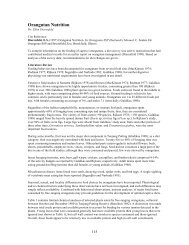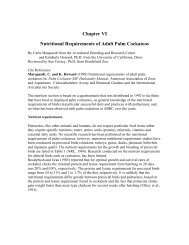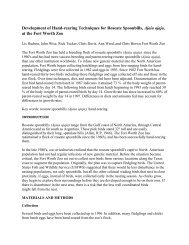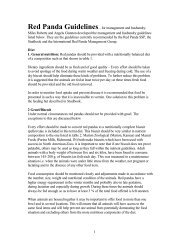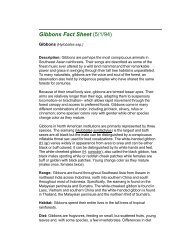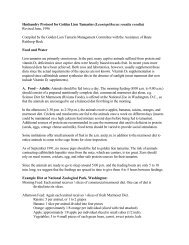Tree Kangaroo Nutrition Chapter - Nutrition Advisory Group
Tree Kangaroo Nutrition Chapter - Nutrition Advisory Group
Tree Kangaroo Nutrition Chapter - Nutrition Advisory Group
You also want an ePaper? Increase the reach of your titles
YUMPU automatically turns print PDFs into web optimized ePapers that Google loves.
3.10 <strong>Tree</strong> <strong>Kangaroo</strong> Husbandry Manual<br />
presented in Table 3.5. The quantity of<br />
browse is limited to no more than three one<br />
meter sections per animal daily; however,<br />
the amount of edible material available is<br />
widely variable. The differences in dry<br />
matter offered and actual dry matter intake<br />
are considered to be filled with browse<br />
consumption.<br />
Based on the information presented here,<br />
both diets (NZP/CRC Diet B and ZSSD) are<br />
appropriate for feeding captive tree<br />
kangaroos. The total quantities and relative<br />
proportions of food categories should be<br />
used as guidelines, in conjunction with the<br />
dietary husbandry information provided, for<br />
review of existing diets.<br />
FOOD PREPARATION/PRESENTATION<br />
A feeding protocol is important in the<br />
management of tree kangaroos. It can help<br />
identify problems, aid in exhibitry and bring<br />
tree kangaroos close to the keeper for close<br />
observations and/or capture. Such a<br />
protocol should include specific times when<br />
an animal should be fed. For example, at<br />
Woodland Park Zoological Gardens the<br />
keepers adopted a feeding regimen based on<br />
reports that D. lumholtzi feed for about 15<br />
minutes every four hours (Procter-Gray<br />
1985). Detailed diet cards are also valuable<br />
keeper reference materials (Steenberg 1996).<br />
The importance of food preparation,<br />
specifically in regard to cutting-up of<br />
commercial produce, varies by institution.<br />
Some institutions designate specific sizes<br />
and shapes that the vegetables should be<br />
cut. Other institutions have found that<br />
animals<br />
show no preference for those vegetables<br />
which are cut in cross section versus<br />
longitudinally. While the vegetable<br />
materials should be large enough to allow<br />
the individual animal to manipulate the<br />
particle, they should also vary enough in<br />
size to provide occupation for the animal.<br />
(Steenberg 1996).<br />
Food pans should be placed in high pan<br />
holders (approximately 4-5 feet off the<br />
ground) or secured to a horizontal platform.<br />
Feeding stations should be up off the<br />
ground. <strong>Tree</strong> kangaroos will often toss<br />
specific items aside to obtain preferred<br />
foods, pushing pans onto the ground in the<br />
process. Pans should be secured to reduce<br />
the amount of food lost to overturned pans.<br />
However, the pan must be removable for<br />
cleaning. Fallen foods are rarely consumed<br />
by captive animals. If the feeder is outside it<br />
should be covered. Also, be aware of how<br />
much transient birds eat if they have access<br />
to the food.<br />
Browse materials should be presented in an<br />
upright fashion. The manner of presentation<br />
was shown to have a significant impact on<br />
consumption levels by captive animals<br />
(Mullett et al. 1990). When browse was<br />
placed in perching or branch materials,<br />
between 90-100% of the edible portion was<br />
consumed. When the same types of plant<br />
materials were “planted” in sand at ground<br />
level, consumption decreased to 65-75%.<br />
Only 50% of the browse was consumed<br />
when the portions were broadcast on the<br />
ground.<br />
Browse may be placed in upright canisters,<br />
such as PVC pipe fitted with a cap on one<br />
end, which is secured to a branch or perch in<br />
the enclosure. This canister may be filled



